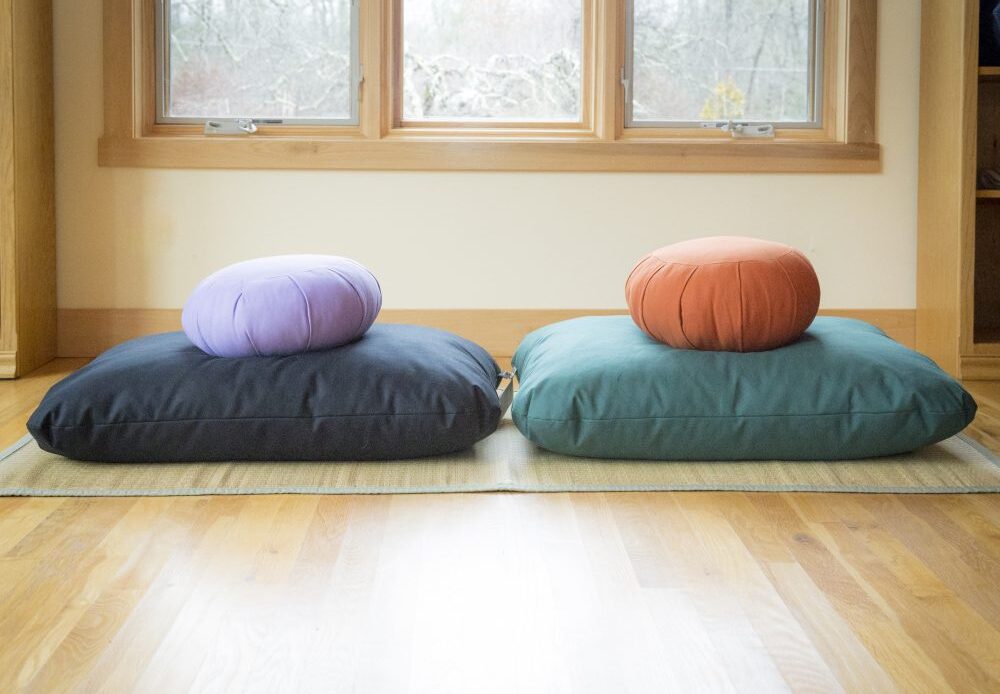
As a dedicated meditator, I know the importance of having the right tools and equipment to support my practice. And when it comes to finding the perfect meditation cushion, there’s no shortage of options to choose from. But with so many different shapes, sizes, and materials available, how do you know which one is right for you?
That’s why I’ve put together this ultimate guide to choosing the perfect meditation cushion. Based on my personal experience and research, I’ll share my top tips and recommendations for finding the perfect cushion to support your practice.
Whether you’re a beginner or an experienced meditator, a comfortable and supportive cushion is essential for a successful meditation practice. In this guide, I’ll cover everything you need to know, from the different types of meditation cushions available to the factors to consider when making your choice.
By the end of this guide, you’ll have all the information you need to confidently choose the perfect meditation cushion for your practice. So let’s get started!
What to look out for in your next meditation cushion
I’ve tried out a lot of different meditation cushions over the years. And while some have been great, others haven’t quite lived up to my expectations.
When choosing a meditation cushion, there are a few key things to look out for to avoid making a mistake. Here are some of the most important factors to consider:
- Size and shape: The size and shape of your meditation cushion can have a big impact on your comfort and support during your practice. For example, if you have longer legs, you may need a larger cushion to support your knees and ankles. Alternatively, if you’re petite, a smaller cushion may be more comfortable. It’s also important to consider the shape of the cushion, as some may be more comfortable for certain meditation positions than others.
- Material: The material of your meditation cushion can also have a big impact on your comfort and support. For example, cushions filled with buckwheat or millet husks are firmer and more supportive, while those filled with cotton or foam are softer and more comfortable. Consider your personal preferences and the type of meditation you practice when choosing the right material for your cushion.
- Weight and portability: If you plan to take your meditation cushion with you on the go, weight, and portability are important factors to consider. Cushions filled with buckwheat or millet husks tend to be heavier, while those filled with cotton or foam are lighter and more portable. Consider how and where you plan to use your cushion when choosing the right weight and portability for your needs.
- Design and aesthetic: Finally, don’t forget to consider the design and aesthetic of your meditation cushion. After all, it’s going to be a part of your meditation space, and you want it to be something that you enjoy looking at and using. Choose a cushion that fits your personal style and the aesthetic of your meditation space.
Overall, there are many factors to consider when choosing the perfect meditation cushion. By taking the time to research your options and choose the right size, shape, material, weight, and design, you can find a cushion that supports and enhances your meditation practice.
How to select a meditation cushion
From meditating for years, I know how important it is to have the right tools and equipment to support my practice. And when it comes to choosing a meditation cushion, there are a few key things to consider to ensure you find the perfect one for your needs.
Here’s my step-by-step guide on how to choose the perfect meditation cushion:
1. Determine your needs
Before you start shopping for a meditation cushion, take some time to think about what you need from your cushion. Consider factors such as your body type, the type of meditation you practice, and where you plan to use your cushion. This will help you narrow down your options and make a more informed decision.
While there are many different types of meditation cushions available, not all of them are right for everyone.
One of the most important things to consider when choosing a meditation cushion is your personal needs and preferences. For example, if you have longer legs, you’ll likely need a larger cushion to support your knees and ankles. Alternatively, if you’re petite, a smaller cushion may be more comfortable. It’s also important to consider the type of meditation you practice, as some cushions may be more suitable for certain positions or techniques than others.
While there are many different types of meditation cushions available, not all of them are right for everyone.
One of the most important things to consider when choosing a meditation cushion is your personal needs and preferences. For example, if you have longer legs, you’ll likely need a larger cushion to support your knees and ankles. Alternatively, if you’re petite, a smaller cushion may be more comfortable. It’s also important to consider the type of meditation you practice, as some cushions may be more suitable for certain positions or techniques than others.
Overall, it’s essential to first determine your needs when selecting a meditation cushion. By taking the time to research your options and choose the right size, shape, material, weight, and design, you can find a cushion that supports and enhances your meditation practice.
2. Consider size and shape
The size and shape of your meditation cushion are important factors to consider. For example, if you have longer legs, you may need a larger cushion to support your knees and ankles. Alternatively, if you’re petite, a smaller cushion may be more comfortable. It’s also important to consider the shape of the cushion, as some may be more comfortable for certain meditation positions than others.
As someone who has been meditating for many years, I can attest to the importance of having the right size and shape for your meditation cushion. The right cushion can provide the support and comfort you need to fully relax and focus during your practice.
When selecting the right size and shape for your next meditation cushion, there are a few key things to consider. Here are some tips to help you choose the perfect cushion for your practice:
- Consider your body size and proportions: The size and shape of your meditation cushion should be based on your body size and proportions. For example, if you have longer legs, you may need a larger cushion to support your knees and ankles. Alternatively, if you’re petite, a smaller cushion may be more comfortable. Take the time to measure your body and compare it to the dimensions of the cushion to ensure a good fit.
- Consider your meditation position: The shape of your meditation cushion should also be based on the position you typically use during your practice. For example, if you like to sit in a cross-legged position, a round or oval-shaped cushion may be more comfortable. Alternatively, if you prefer to sit on your heels, a rectangular cushion may be a better fit. Consider your personal preferences and the type of meditation you practice when choosing the right shape for your cushion.
- Try before you buy: If possible, try out the cushion before you buy it. This will give you a chance to experience the size and shape of the cushion, and see how it feels during your practice. Many meditation centers and online retailers offer the opportunity to try out meditation cushions, so take advantage of this opportunity to ensure the perfect fit.
The right size and shape of the meditation cushion can make a big difference in your comfort and support during your practice. By considering your body size and proportions, your meditation position, and trying out the cushion before you buy, you can find the perfect cushion for your needs.
3. Choose the right material
The material of your meditation cushion can also have a big impact on your comfort and support. For example, cushions filled with buckwheat or millet husks are firmer and more supportive, while those filled with cotton or foam are softer and more comfortable. Consider your personal preferences and the type of meditation you practice when choosing the right material for your cushion.
Choosing the right material for your meditation cushion is an important decision that can have a big impact on your comfort and support during your practice. I’ve tried out a variety of materials, and I’ve found that some work better for me than others.
Here are some of the most common materials used in meditation cushions, along with their pros and cons:
- Buckwheat or millet husks: Cushions filled with buckwheat or millet husks are firmer and more supportive, making them a good choice for meditators who prefer a more stable and solid surface. However, these materials can be noisy and may not be as comfortable for extended periods of sitting.
- Cotton or foam: Cushions filled with cotton or foam are softer and more comfortable, making them a good choice for meditators who prefer a more comfortable and plush surface. However, these materials may not provide as much support and stability as firmer materials.
- Organic materials: Some meditation cushions are filled with organic materials like organic cotton or kapok, which are sustainable and eco-friendly. These materials can provide a comfortable and supportive surface, but they may not be as durable as other materials.
Ultimately, the right material for your meditation cushion will depend on your personal preferences and the type of meditation you practice. Consider your needs and try out a few different materials to find the one that works best for you.
4. Consider weight and portability
If you plan to take your meditation cushion with you on the go, weight and portability are important factors to consider. Cushions filled with buckwheat or millet husks tend to be heavier, while those filled with cotton or foam are lighter and more portable. Consider how and where you plan to use your cushion when choosing the right weight and portability for your needs.
The right weight and portability will depend on how and where you plan to use your cushion.
For example, if you plan to use your cushion primarily at home, weight and portability may not be as important. In this case, you can choose a cushion that’s heavier and less portable, as long as it’s comfortable and supportive. Cushions filled with buckwheat or millet husks are firmer and more supportive, but they tend to be heavier and less portable.
On the other hand, if you plan to take your cushion with you on the go, weight and portability become more important. In this case, you’ll want to choose a cushion that’s lightweight and easy to transport. Cushions filled with cotton or foam are softer and more comfortable, but they are also lighter and more portable.
It’s also important to consider the type of meditation you practice when choosing the right weight and portability for your cushion. For example, if you practice sitting meditation, you may not need a cushion that’s as portable, as you’ll be using it in one place. However, if you practice walking or moving meditation, you’ll want a cushion that’s lightweight and easy to carry with you.
Overall, the right weight and portability for your meditation cushion will depend on your personal preferences and the type of meditation you practice. Consider how and where you plan to use your cushion and choose the right weight and portability for your needs.
5. Select a design you love
Finally, don’t forget to consider the design and aesthetic of your meditation cushion. After all, it’s going to be a part of your meditation space, and you want it to be something that you enjoy looking at and using. Choose a cushion that fits your personal style and the aesthetic of your meditation space.
I know that the design of your meditation cushion can have a big impact on your practice. Not only does it affect the aesthetic of your meditation space, but it can also influence your comfort and support during your practice.
So, how do you choose the right design for your meditation cushion? Here are some tips and considerations to keep in mind:
- Your style: When choosing the design of your meditation cushion, it’s important to consider your personal style and preferences. After all, you’re going to be using this cushion regularly, and you want it to be something that you enjoy looking at and using. So, think about the colors, patterns, and textures that you love, and choose a cushion that reflects your personal style.
- The aesthetic of your meditation space: In addition to your personal style, it’s also important to consider the overall aesthetic of your meditation space. Your meditation cushion is going to be a part of that space, and you want it to fit in and enhance the overall look and feel of the room. So, think about the colors, patterns, and textures that are already present in your meditation space, and choose a cushion that complements and enhances those elements.
Choosing the design of your meditation cushion is a personal and important decision. By considering your personal style, the aesthetic of your meditation space, the function of your cushion, and your budget, you can find a design that enhances and supports your meditation practice.
6. Types of meditation you practice
The type of meditation you practice can be a key factor in determining the right meditation cushion for you. Different types of meditation require different positions and support, and choosing the right cushion can make a big difference in your comfort and ability to focus during your practice.
For example, if you practice seated meditation, you’ll want a cushion that provides support for your hips and lower back. A cushion with a firm and supportive filling, such as buckwheat or millet husks, can help you maintain proper alignment and reduce discomfort in your lower back and hips.
On the other hand, if you practice lying down meditation, such as Yoga Nidra or savasana, you’ll want a cushion that provides support for your head, neck, and shoulders. A cushion with a softer filling, such as cotton or foam, can help you maintain proper alignment and reduce discomfort in your head, neck, and shoulders.
Additionally, if you practice dynamic meditation, such as walking or chanting meditation, you’ll want a cushion that is lightweight and portable. This will allow you to easily take your cushion with you on the go, and provide support and comfort wherever your practice takes you.
Overall, the type of meditation you practice should be a key factor in determining the right meditation cushion for you. By considering the positions and support required for your specific type of meditation, you can choose a cushion that enhances your practice and supports your comfort and focus.
Overall, choosing the perfect meditation cushion takes some time and consideration. By following these steps and considering your needs, you can find a cushion that supports and enhances your meditation practice.
Viesearch – The Human-curated Search Engine
